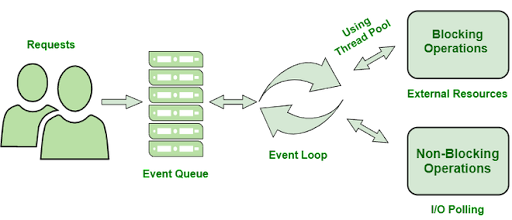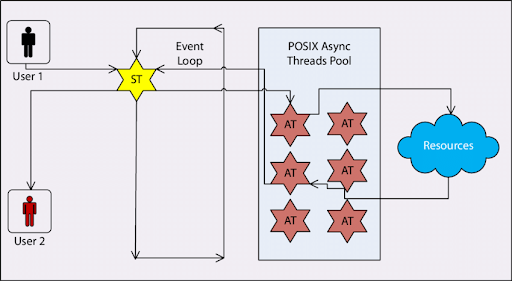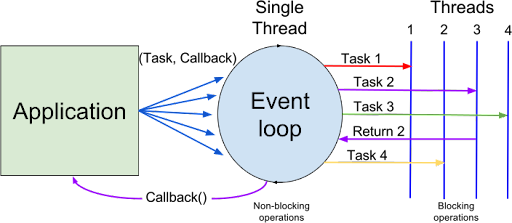Node.JS Architecture: A Detailed Look for Your Next Project

Increasing penetration of mobile apps has transformed several facets of web development. One major change is that it has surely changed users’ expectations from brands. And this change has compelled developers to build web applications that behave more like native applications and deliver seamless user experience across all devices and browsers. Moreover, many programming languages and frameworks are being launched to build flawless applications, but Node.js architecture provides a better feature set than others.
Highlights
- 1 Node.JS Architecture: A Detailed Look for Your Next Project
As we know, JavaScript is a major language that has dominated the market for decades. It is a robust and powerful scripting language that helps create client-side applications, but the limitation is it can’t execute applications on the server side. Hence, using Node.JS is preferable as it offers best practices and makes it easy for developers to build fast and highly scalable applications while handling huge amounts of connections having high throughput.
Most of the full-stack developers today use Node.js as it is the most efficient solution to problems where traditional solutions have lots of redundancy. Moreover, it is one of the most loved open source, cross-platform, and JavaScript-based runtime environments. Big corporations like Amazon, eBay, Netflix, etc., use it; more than 43% of developers today use Node.JS to build enterprise applications. Even so, Node.js’s popularity should motivate you to get to know its intricacies.
The Node.JS platform offers libraries, logic, and types that can be reused across front-end and back-end applications. A developer skilled enough to work on any part of the application was born as a result of this trend – the full-stack developer archetype. Many large enterprises use it for critical infrastructure, which was once considered a questionable technology. This language performs high-volume IO operations exceptionally well, and its code complexity is much lower than those of languages that rely heavily on multi-threading.
Now without any ado, let’s have a look at its architecture. The Node.JS architecture is thoroughly explained in this blog, starting on the client side and ending on the server. We will also understand why Node.js Architecture is so popular and what makes it better than other architectures.
Introduction to Node.js Architecture
The Single-Threaded Event Loop Model of Node.js architecture will help us better understand the advantages Node.js has, including handling concurrent requests without creating multiple threads and using fewer threads to utilize fewer resources. A big reason for Node.js’ popularity with developers is its mechanics. With Node.js, no multi-threading is involved, as is the case with most other runtime environments.
Fundamentally, there are two types of threading involved
- Multi-threading
- And single threading
In multiple-threaded processing, a thread is picked out every time a request is made until the allotted threads are exhausted. A busy thread must wait until a free one becomes available before the server can proceed. Slow and inefficient applications can have a negative impact on everything from customer experience to lead conversion.
The Node.js programming language, however, uses a single-threaded processing model. Input/Output operations in a single-thread architecture are handled using event loops to handle blocking operations in a non-blocking manner, while multi-thread architectures process every request as a single thread.
This is what the founder, Ryan Dahl had in mind when he first launched Node.js, and this is one of the reasons why Node.js frameworks also are popular among web application developers.
This was the basics of architecture. Now, please deeply dive into the Node.JS architecture and its modules.
Node.JS Architecture in Detail

A multi-threaded model is generally used in server-side technologies, including PHP, ASP.NET, Ruby, and Java servers. Traditional architectures create threads or processes for each client request. Node.js takes advantage of the Single Threaded Event Loop Model Architecture to prevent this. It indicates that all client requests for Node.js are processed through a single thread. But in addition to being single-threaded, this design is also event-driven. As a result, it enables Node.js to manage several clients at once.
It uses two concepts in its architecture: non-blocking I/O operations and the asynchronous paradigm, which is comparable to JavaScript’s event-based model. Let’s first establish what Node Architecture is made of before we delve deeper into how it functions. Node’s architecture is composed mostly of six elements which are discussed below:
Requests: A request is the most fundamental building block that underpins all backend architectural concepts. A request is only a message describing the task a user wishes to do. They can be complicated or obstructive or simple or non-complex.
Node.js Server: The server, which is the second element, is the foundation of the architecture. The server is a server-side application that accepts requests from users, processes them, and then returns results that are pertinent and what was requested.
Event Queue: When a request is made, it is added to a list of pending requests called the event queue. Once the necessary resources are available to handle that request, it is removed from the event queue.
Thread Pool: Each server has a set number of threads or a thread pool. The server’s hardware design affects the number of threads. The thread pool refers to the entire collection of threads in a server.
Event Loop: This is a loop that never ends. It continues to receive and process requests from the event queue. Finally, the associated clients receive the response.
Finally, last but not least, we have external resources—resources that are not part of the Node design but may be needed to fulfill a client request. These might include file systems, databases, etc.
These basic elements play the most important role in Node.js architecture, but you should also know how these elements work together and what flow Node.js architecture follows.
Working Flow of Node.js Architecture

The workflow for Node.js architecture is as follows. Incoming and outgoing requests fall under two categories. Incoming requests can either be basic, which equates to non-blocking, or complex, which equates to blocking. It depends on the task that users of the web application or software are supposed to do.
- Searching for specific data in a database is referred to as querying.
- Sending a request to delete a specific piece of data or running a delete query are both examples of removing data.
- When you update data, you either send a request to edit or update a specific piece of data or run an updating query on a specific table row to update a particular database record.
- The requests from arriving clients are retrieved by Node.js and added to its Event Queue.
- The event loop then receives the incoming requests one at a time and determines whether or not each one calls for external resources. If so, such requests are subsequently assigned to external resources; otherwise, the process proceeds to the next stage.
- Non-blocking (simple) requests are handled by Event Loop using I/O polling and returned to the appropriate clients as a response.
Following the aforementioned stages, each complex request is given a single thread from the thread pool. This thread is in charge of assigning external resources, such as databases, file systems, etc., to fulfill certain blocking requests.
It is a single-threaded event loop model because after the task is complete, the response is sent back to the event loop, which then sends it to the client.
We have talked too much about single thread work, but how does it work? Let’s discuss it in the next section.
Single Threaded Event Loop Architecture in Node.js

Node.js is frequently misunderstood as doing all operations in a single thread. How is that even conceivable? With only one thread, how could it compete with competing for multi-threaded frameworks?
The V8 Javascript engine from Chrome serves as the foundation for Node.js, which is effectively a Javascript runtime. This indicates that it is built on the single-threaded architecture of Javascript. As a result, a single main thread processes each client request that comes in.
The event loop is the main element that enables Node.js to execute (otherwise blocking) I/O operations in a non-blocking manner. Your asynchronous tasks (such as the code in your callback functions) are continuously monitored by it, and it pushes them back to the execution queue once they are finished. It functions.
“Event Loop” is the beating heart of the Node.js Processing paradigm. If we grasp this, then it is extremely straightforward to understand the Node.js Internals.
It can set aside an asynchronous task when it encounters one and continues working on another task until the asynchronous task is finished. However, if you perform lengthy, CPU-intensive activities, it will spend too much time on one activity, delaying others. The general idea is to avoid blocking the event loop for pricey activities so that we may fully take advantage of its switching mechanism.
It’s better to stay away from serving assets from a Node server for the same reason. A CDN or even an S3 bucket works best for serving HTML, CSS, JS files, and images. Node performs best when used for applications that require a lot of IO. If implemented correctly, Node’s single-threaded event loop can provide performance comparable to that of a programme using several threads.
Best Practices to Follow in Node.js Architecture
Node.js is gaining immense popularity as it occupies the 6th position on the list of most-used web technologies. So it is a perfect choice for making up-to-date solutions supported by various services and sockets. In short, Node.js is a sensation today, and to make the most out of it; developers should be well equipped with its practices. Here, we are going to highlight some of the best practices to keep in mind when starting to work on any Node.js development project.
First, Build a Folder Composition
If you want the best application on the market, we know how accurate every component must be, and a folder is a perfect spot to organize the fundamental components.
Use Easily Readable and Clean Codes
Every developer should strive to write better, more readable code. A code linter and formatter are standard components of most code setup operations. A linter alerts you to grammatical and semantic errors in the code.
Follow Layered Approach
Node.js architecture follows three layers,
- Controller
- Service layer
- Data access layer
Most Node.js applications can be built atop a solid foundation of the above three layers, which makes it simpler to create, maintain, debug, and test your apps.
Business Logic and API Routes
Amazing frameworks include Express.js. They provide incredibly unlikely functionality for controlling requests, views, and routes. We could be excited to embed business logic in API routes with such direction.
Write Asynchronous Code
Javascript’s callback functions are well known (functions that can be passed as an argument to other functions). They also let you create asynchronous Javascript behaviour. The issue with callbacks is that as the number of chained activities rises, your code becomes more cumbersome and bloated, leading to what is dubbed “callback hell.” To address this, ES 6 (ECMASCRIPT 2015) released the Promises API, which greatly simplified the process of writing asynchronous Javascript code.
Child Processes
Node.js can create child processes to assume responsibility for tasks while being single-threaded. However, an excessive number of child processes will significantly slow down the completion of your code, despite being effective when used judiciously.
Use Third-party Solutions
There is a sizable developer community for NodeJS worldwide. With support for third-party frameworks, libraries, and tools for all conceivable use cases, NPM, or the Node package management, is a feature-rich, well-maintained, and well-documented package. As a result, developers may easily incorporate all of these solutions into their applications and leverage their APIs to the fullest extent.
Unit Testing
A particularly important phase in developing our application is testing. Bugged code can slow down the process and make things more difficult because it depends on the project’s overall flow rather than just the outcome. Testing offers several benefits, such as:
- Improve code quality
- Can find bugs earlier
- Cost reduction
Apart from these, there are many other practices to follow for better web development, but here we have tried to cover the best practices that help you structure your project and hone the developer’s skills.
Polishing Off About Node.js Architecture
As we mentioned earlier, big companies have adopted Node.js. Why? Because it offers some exceptional benefits that other frameworks do not offer. From scalability to performance to an easy and quick development process, Node.js has it all to offer. Additionally, the popularity of Node.js has been growing steadily since its release, and the trend seems here to stay for a long time.
The performance of an entire web application depends on the backend technology, and choosing the best one is not a walk in the park. In order to build scalable web applications, you need to hire Node.js developers who are experienced so that their expertise results in building flawless applications.
Moving further, let’s discuss the advantages of using Node.js architecture for your web application development.
- Scalable
- Cost reduction
- Easy-to-market development
- Handles multiple request easily
- No multiple threads are required
- Reusable code
- Supported by leading corporations
One of the most important benefits is that there will be a lot of assistance and comments in an active community. Node.js is fortunate to have a sizable community of programmers who continually work to advance it. Additionally, there are numerous community forums for Node.js, including Stack Overflow, Reddit, Nodebb, Dev. to, and Github.
Wrapping Up
For the development of both web and mobile applications, Node.js has grown very popular. It works well for developing apps that frequently move data from a client to a server and include many client-side renderings. A Node.js application’s development presents a unique set of difficulties. It should be your goal to write clean, reusable code.
Node.js is an open-source, cross-platform JavaScript runtime environment for developers who aim to build dynamic and robust web applications. If you are new to the technology field and want to develop a robust nodejs platform, consider Elluminati Inc without having any second thoughts, as it is one of the best companies with a talented pool of developers who are always eager to help you build unique products with optimal resources.



